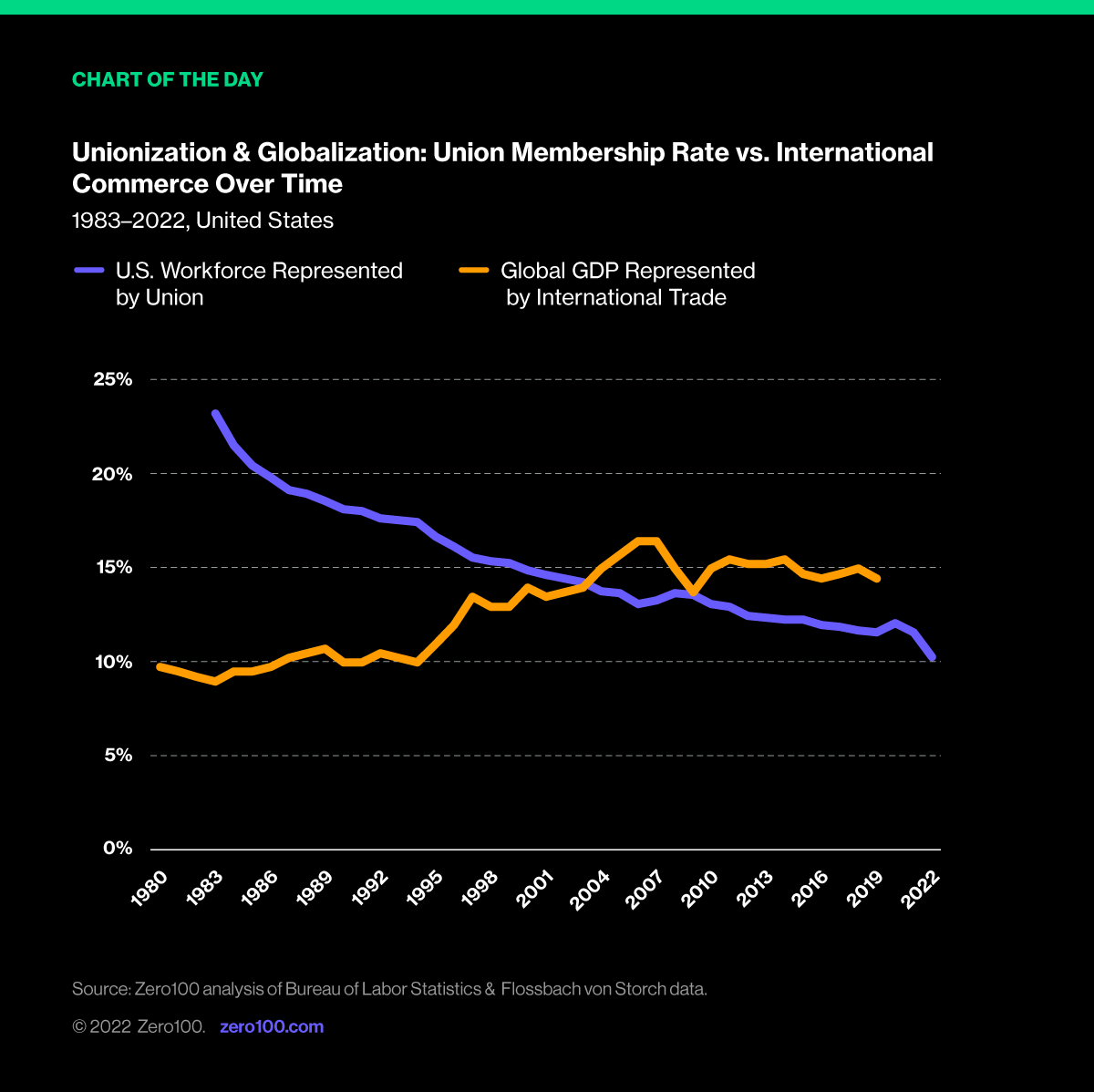
Labor: Think Global, Organize Local
Once is happenstance. Twice is coincidence. Thrice is a pattern. Recent unionization efforts in New York require us to examine the wider environment that has set the stage for a “new labor movement” (and its potential impact on future operations).
The Times They Are A-Changin'
Last Friday, Amazon employees at the JFK8 Fulfillment Center voted by a 25% margin to become represented by the Amazon Labor Union (ALU). The organizer behind this result was 33-year-old Chris Smalls, a former Amazon worker who gained notoriety following a COVID-triggered walkout in March 2020. In two short years, the ALU pulled off what no large, well-established union equipped with scale and capital could deliver in decades.
More importantly, the developments in Staten Island appear far from an isolated incident. On the same day, the Starbucks Workers United won its tenth victory since December 2021, converting the coffee chain's Reserve Roastery New York to a union shop. Last month, workers at REI's SoHo flagship store voted to become the first among the progressive retailer's 170+ stores to join the Retail Wholesale and Department Store Union. And down in Bessemer, Alabama, a contested union vote at another Amazon warehouse appears to have narrowed considerably from a decisive 2-to-1 defeat as recently as April 2021.
WHAT. IS. GOING. ON?
In the Long Term...
In January, the Bureau of Labor Statistics (BLS) released its annual Union Member Summary describing the U.S. workforce. This year's report confirmed that union membership is on a trajectory to dip below 10% of the overall workforce for the first time on record – continuing its precipitous decline since peaking in 1955, when over a third of U.S. workforce participated in organized labor.
So, from a long-term perspective, the developments above are a drop in the bucket. But as the granddaddy of modern macroeconomics famously stated: “In the long-term, we're all dead...” Focusing instead on the here and now, the news of the day and the punditry around a “new labor movement” are well worth unpacking.
My initial thoughts are as follows:
1. Historically, Unions Prove Unresponsive to Systemic Change
The unions of old (AFL-CIO, Teamsters, UAW, USW, etc.) reflect the industries of old. Hallmarks of mass production that quickly followed in the wake of the second Industrial Revolution (e.g., steel, automobiles, aviation) were highly centralized, labor-intensive, and capital-intensive. Effective unions continued to maximize the utility of their membership, as long as the underlying models of production did not change.
2. The Rise & Fall of Unions is Tied as Much to Trade as to People
The long process of de-unionization has a mirror image in the form of rising rates of world merchandize trade, calculated as a percentage of global GDP. As soon as labor and capital are endowed with high mobility and high substitutability starting in the 1980s, collective bargaining quickly gives way to the purported virtues of “labor flexibility.”

3. As the Supply Chain Grows in Complexity, it is More Susceptible to Localized Action
Despite the union-busting track record of large technology and service providers—the true enemy of scale (in warfare, public policy, or business) are small, agile, dedicated groups that deploy new tactics (read: digital) to equalize the playing field.
The Young and the Restless
Based on the morbid quote cited above, a lot of people assume John Maynard Keynes didn't care about the ramifications of public policy on future generations. This is largely because annoying authors that still cite Keynes truncate the full quotation: “. . . Economists set themselves too easy, too useless a task if, in tempestuous seasons, they can only tell us that when the storm is long past, the ocean is flat again.”
The events of the past week are striking because they have the same ominous sound as the squeal of a rusty weathervane as it begins it slow turn in anticipation of a storm.
Consider: the average Millennial has experienced the slowest economic growth of ANY other generation in U.S. history. Moreover, elder Millennials are now managing younger Gen Zers entering the workforce en masse. Based on various demographic studies, Gen Zers (born 1997-2012) appear bred to organize for action. They are technology-based, but not antisocial. In fact, they prefer face-to-face style communication and adopt team persuasion as a method to expedite decision-making. Most importantly, they don't seek opportunity or incremental improvement, they EXPECT change.
This unique combination of frustration plus effectiveness among younger cohorts suggests a powerful reagent for collective action (beyond the Great Resignation). Put more simply, if a 16-year-old can inspire and organize a “walkout” of four million people from her smartphone, the “new labor movement” might buck a long-standing trend—coinciding directly with a period of de-globalization, re-shoring, and localization.
Coincidence? No such thing...
Critical Reading
FORBES
The Kids Are Alright: How Generation Z is Pushing Others to Demand Supply Chain Sustainability
Commentary: Fascinating Gen Z profile linking the cohort's inversion of values from brand recognition to sustainability with new traceability solutions for retail and fashion brands struggling to keep pace with changing customer tastes and preferences.
#GenZ #Sustainability #Fashion
THE NEW YORK TIMES
Stopping Climate Change is Doable, but Time Is Short, U.N. Panel Warns
Commentary: The latest report from the Intergovernmental Panel on Climate Change examines dozens of strategies proposed by scientists and energy experts to accelerate the transition to Net Zero, including a new framework to compare the scale of adoption vs. time to deliver on competing strategies.
#Decarbonization #2030 #UN
BLOOMBERG
U.S. Supply Chain Pressures Soar to a Record, Index Shows
Commentary: Driven up by warehouse pricing and diesel fuel prices (+64% YoY), the Logistics Managers' Index released last week hit a record level. But authors contend continued inventory congestion may also be a sign that suppliers are getting smarter about where and how to stockpile goods as a hedge against inflationary trends.
#Transportation #Logistics #Inflation